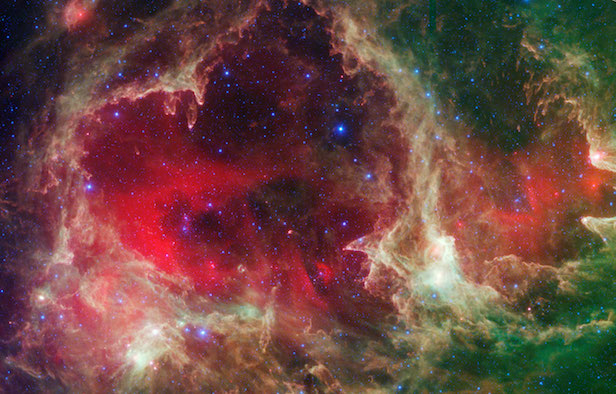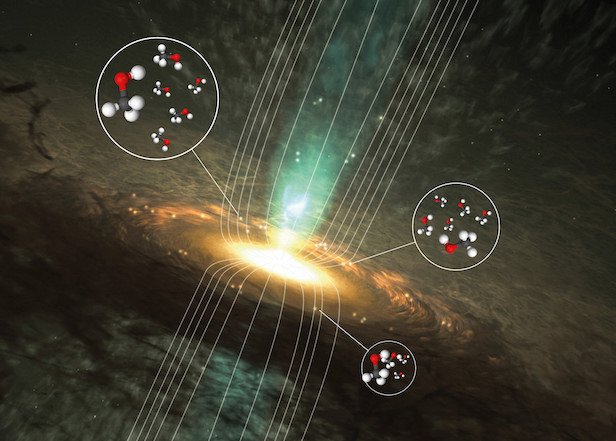Alcohol could reveal the nature of cosmic magnetic fields
Analysing methanol molecules using radio astronomy can reveal how magnetic fields affect the formation of massive stars

Understanding how massive stars form can paint a fuller picture of stellar evolution for astronomers. Image credit: L. Allen/X. Koenig (CfA)/JPL-Caltech/NASA
Complex molecules are scattered throughout the universe, and only in recent times have they been detectable. Now scientists have been able to measure magnetic fields in space using the molecule methanol, the simplest form of alcohol. The results from this study will help astronomers investigate how massive stars are born in dense and dark clouds.
Radio astronomy has been the driving forces behind the discovery of many different molecules in space. By understanding the nature of these molecules, astronomers can uncover what happens within the darkest and densest clouds of gas and dust in which new stars are born.
Studying the signatures of these molecules can tell astronomers about the temperature, pressure and gas motions of such clouds. When the most massive stars are born, another important aspect needs to be measured but causes more of a problem: magnetic fields.
“When the biggest and heaviest stars are born, we know that magnetic fields play an important role. But just how magnetic fields affect the process is a subject of debate among researchers,” says Boy Lankhaar, of Chalmers University of Technology. “So we need ways of measuring magnetic fields, and that’s a real challenge. Now, thanks to our new calculations, we finally know how to do it with methanol.”
The technique of using methanol (CH3OH) in space to study magnetic fields was suggested many decades ago. In the mists of the dense gas that encompasses newborn stars, methanol molecules act as a natural microwave laser, or masers. Methanol masers shine extremely brightly at specific radio frequencies.
“The maser signals also come from the regions where magnetic fields have the most to tell us about how stars form,” says Wouter Vlemmings, also of Chalmers University of Technology. “With our new understanding of how methanol is affected by magnetic fields, we can finally start to interpret what we see.”

Magnetic fields play an important role in the clouds of gas and dust where the universe’s most massive stars are born. Image credit: Wolfgang Steffen/Chalmers/R. Lankhaar/Wikimedia Commons/B. Mills
Earlier attempts to measure the magnetic properties of methanol in laboratory conditions have met with problems. Because of this reason, scientists decided to build a theoretical model that satisfies previous theories as well as laboratory measurements.
“We developed a model of how methanol behaves in magnetic fields, starting from the principles of quantum mechanics,” explains Lankhaar. “Soon, we found good agreement between the theoretical calculations and the experimental data that was available. That gave us the confidence to extrapolate to conditions we expect in space.”
Unfortunately, the task turned out to be more challenging than expected. The work done by theoretical chemists Ad can der Avoird and Gerrit Groenenboom, both of Radboud University in the Netherlands, included new calculations to correct previous work.
“Since methanol is a relatively simple molecule, we thought at first that the project would be easy. Instead, it turned out to be very complicated because we had to compute the properties of methanol in great detail,” says Ad van der Avoird.
The latest results have now opened new possibilities for understanding magnetic fields in space. The work has also showed how astrochemistry – where astronomy and chemistry combine – can answer important questions about the cosmos.
“It’s amazing that such detailed calculations are required to reveal the molecular complexity which we need to interpret the very accurate measurements we make with today’s best radio telescopes,” says Huib Jan van Langevelde, astronomer at the Joint Institute for VLBI ERIC and Leiden University. “It takes experts from both the chemistry and astrophysics disciplines to enable new discoveries in the future about molecules, magnetic fields and star formation.”
Keep up to date with the latest reviews in All About Space – available every month for just £4.99. Alternatively you can subscribe here for a fraction of the price!




